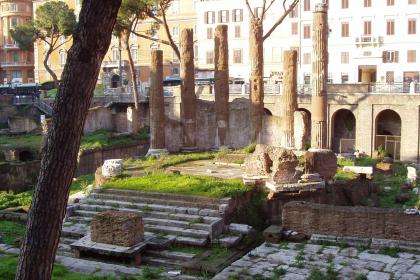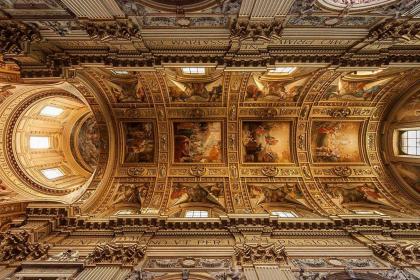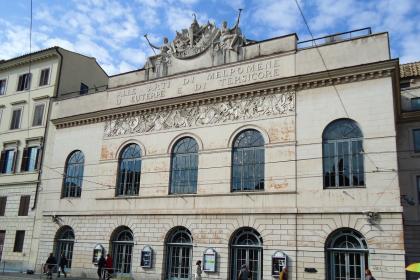
Little historical information is available on the life of St. Julian, popularly known as the Hospitaller. According to one of the many versions of the story Julian was born in today’s Belgium in the 7th century and he was an impulsive and easy to anger noble man. After mistakenly killing his parents, he devoted the remainder of his life to atonement and prayer, caring for the poor and pilgrims around Europe. The patron of hoteliers and travelers, he became popular all across Western Europe inspiring writers such as Flaubert in “Trois contes”. To him is dedicated the small church behind the Teatro Argentina, in the Rione Sant’Eustachio.
According to tradition, the church was founded when Flanders converted to the Christian faith, during the pontificate of Gregory II in the 8th century. But it was probably in the 11th century that the Christian community of Flemish expatriates in Rome built a hospice for their fellow-countrymen, both pilgrims and visitors, with a chapel dedicated to their patron saint. Robert II, Count of Flanders, who arrived in Rome in 1096 to participate in the crusade banned by Urban II, possibly stayed at a hospice and oversaw its restoration. The first historical mentions, however, date back to the mid-15th century, and precisely to 1444, when the Confraternita dei Fiamminghi that ran the hospice wrote their statutes and regulations. In the following centuries the complex underwent a number of restorations: between 1680 and 1682 the confraternity expanded the church and refitted it on an elliptical plan. The French Revolution put an end to the activity of the hospice, that was later made the home of the Belgian College (now moved to Via Aurelia). The title to the property of the church was first transferred to Netherlands and then to the new Belgian government. It is today the national church of Belgium and the complex continues to be administered by the Stichting Sint-Juliaan, a secular foundation which is the descendent of the old confraternity.
The little façade is inserted into the larger building of the former hospice. The doorcase has a carving of the lion rampant from the shield of the County of Flanders. Above this an arched niche with contains a modern copy of a 17th century statue of St Julian the Hospitaller. The original, now kept in the Foundation’s meeting room, was carved in elm by Jodocus Haerts in the mid-17th century. Inside, the ceiling vault shows the gilded shields of the cities of Bruges, Ghent and Ypres and, in the center, a fresco with the Glory of St. Julian made in the early 18th century by the English artist William Kent, better known as the landscape gardener and architect of the English sovereigns. Noteworthy is the monument to Ludovica de Timbrune-Valence, erected in 1830 by Matthieu Kessels, one of the leading representatives of Belgian classicism. The noblewoman was the wife of the then Belgian ambassador and is invited into into heaven by her pre-deceased daughter in the form of an angel: a spectacular sculptural group in white marble that well expresses the art of the 19th century.
Sacred Area of Largo di Torre Argentina

 Condividi
Condividi
Basilica of Sant'Andrea della Valle

 Condividi
Condividi
Teatro di Roma - Teatro Argentina

 Condividi
Condividi
Information
For the timetable of the masses and visiting conditions, please consult the contacts.
 Condividi
Condividi
Location
To find out about all accessibility services, visit the Rome accessible section.











































